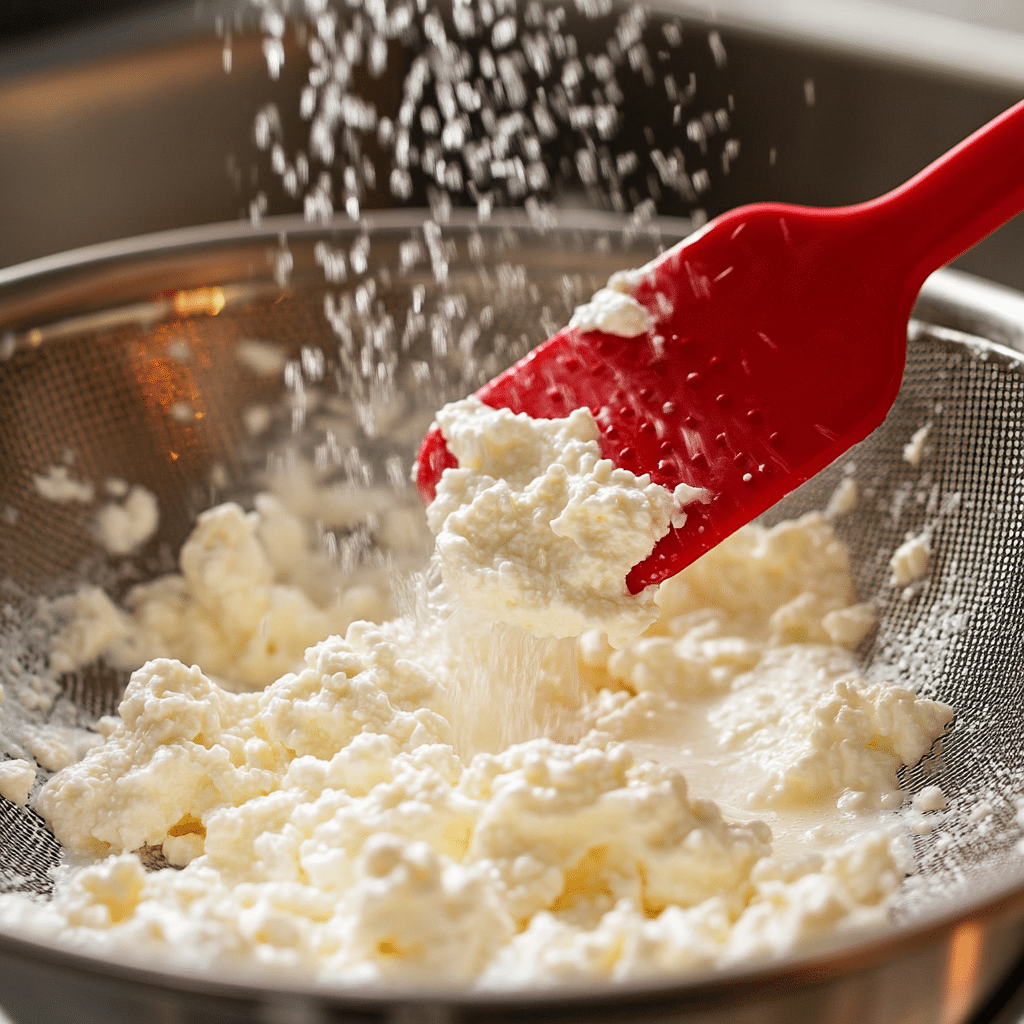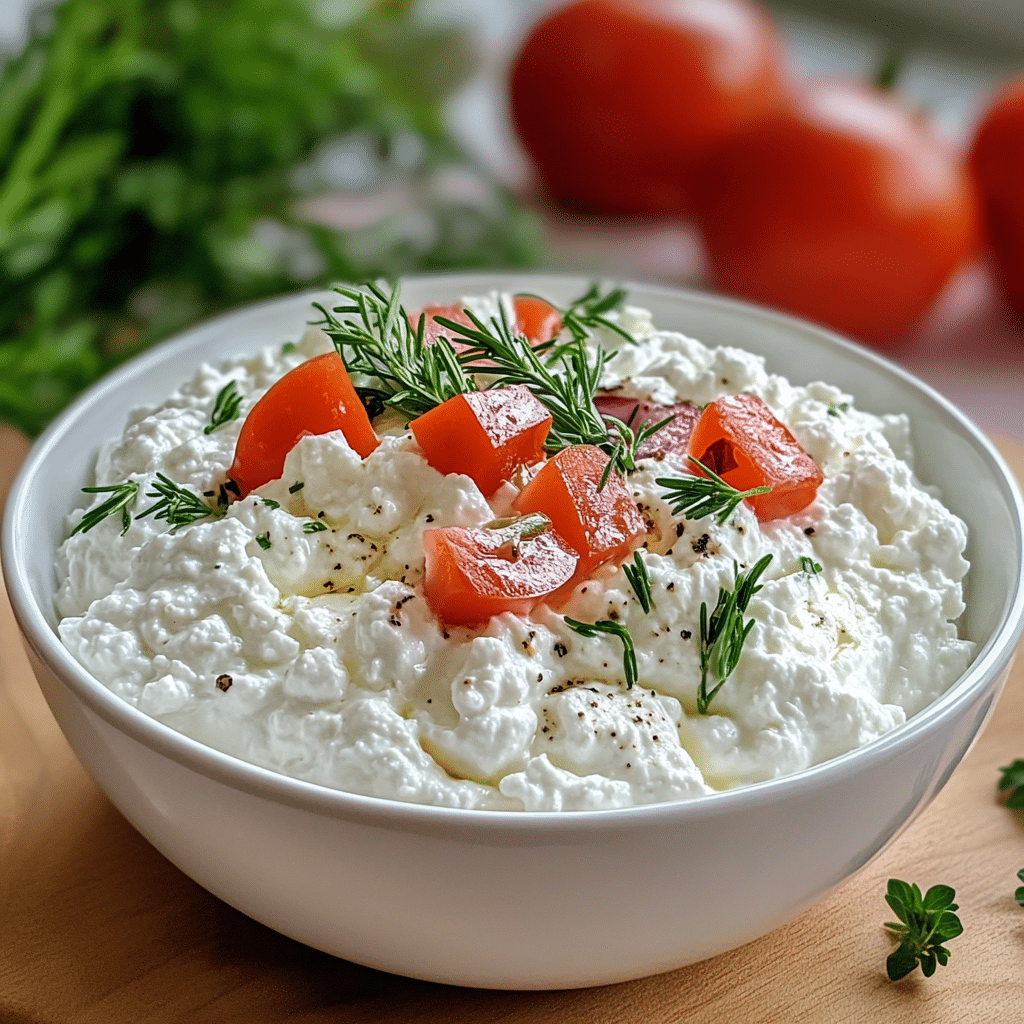Low sodium cottage cheese is a smart and tasty choice for anyone wanting to enjoy creamy cheese while keeping their sodium intake in check. I’m Emma, the voice behind Meals with Emma, a space where I share quick and delicious gluten-free recipes designed for those living with Celiac Disease, gluten sensitivities, or anyone aiming to eat healthier every day.
In this guide, you’ll explore how to pick the best low sodium cottage cheese, reduce sodium at home, and find the healthiest options available. Let’s dive in and make healthy eating simple and satisfying!
Check out these cottage cheese bagels for a perfect pairing.

Table of Contents
Understanding Low Sodium Cottage Cheese
What is Low Sodium Cottage Cheese?
Low sodium cottage cheese is simply cottage cheese that contains significantly less salt than traditional versions. While regular cottage cheese can pack upwards of 400 mg of sodium per ½ cup serving, low sodium varieties typically contain 100–200 mg or even less.
This lower sodium option is ideal for people managing high blood pressure, heart disease, or anyone following a low sodium diet. It offers the same creamy texture and mild flavor you love but with a fraction of the salt. Thanks to growing consumer demand, many brands now offer reduced-sodium or no-salt-added versions — making it easier than ever to enjoy cottage cheese without worrying about sodium overload.
Why Choose Low Sodium Options?
There are plenty of reasons why low sodium cottage cheese belongs in your fridge:
- Heart Health: High sodium intake can increase blood pressure, a major risk factor for heart disease and stroke. Reducing your sodium helps protect your heart.
- Better Fluid Balance: Lowering sodium can help reduce bloating and water retention.
- Improved Kidney Health: Less sodium lightens the load on your kidneys, promoting better overall health.
- Tastes Great: Many reduced-sodium options retain all the creamy texture and rich taste of regular cottage cheese.
Discover great ideas like these low-carb bagels perfect with a scoop of low sodium cottage cheese.

Low Sodium Cottage Cheese Power Bowl
Equipment
- serving bowl
- spoon
Ingredients
- 1/2 cup low sodium cottage cheese
- 1/2 cup fresh mixed berries (strawberries, blueberries, raspberries)
- 1 tbsp chia seeds or ground flaxseed
- 1 small handful of granola (low sodium, optional)
- drizzle of honey or maple syrup (optional)
Instructions
- Place the low sodium cottage cheese in a serving bowl.
- Top with fresh mixed berries of your choice.
- Sprinkle chia seeds or ground flaxseed evenly over the bowl.
- Optionally, add a small handful of granola and drizzle with honey or maple syrup if desired.
- Serve immediately and enjoy as a quick, nutritious meal or snack.
Notes
Nutrition
Health Benefits of Low Sodium Cottage Cheese
Supports Heart Health
One of the standout reasons to choose low sodium cottage cheese is its heart-friendly profile. Excess sodium can lead to elevated blood pressure, increasing the risk of heart disease and stroke. By switching to low sodium varieties, you can still enjoy the creamy goodness of cottage cheese while helping to keep your blood pressure in a healthy range.
Cottage cheese is also packed with protein and calcium, two nutrients that support cardiovascular health. The combination of low sodium and high protein makes it a smart addition to heart-healthy meal plans.
Helps Manage Blood Pressure
Reducing sodium intake is one of the most effective ways to manage blood pressure naturally. Since traditional cottage cheese is often high in sodium, opting for low sodium cottage cheese allows you to enjoy this versatile food without sabotaging your blood pressure goals.
Incorporating more potassium-rich foods alongside low sodium cottage cheese — such as leafy greens, bananas, and sweet potatoes — can further support healthy blood pressure levels.

How Sodium Affects Cottage Cheese
How Sodium is Added During Processing
To understand low sodium cottage cheese, it helps to know how sodium is typically introduced. During production, salt is commonly added to cottage cheese not only to enhance flavor but also to act as a preservative. The added salt helps prevent spoilage and improves shelf life by limiting bacterial growth, all while contributing to the cheese’s creamy and savory profile.
That said, not all cottage cheese needs to be heavily salted. Many brands now produce low sodium options by minimizing the salt used or by rinsing the curds to naturally lower their sodium content. As you shop, check packaging for terms such as “lower sodium,” “reduced salt,” or “no salt added” to find the best options. These labels make it easy to select products that align with your dietary needs.
Impact of Sodium on Flavor and Texture
Sodium significantly influences the flavor profile of cottage cheese. Higher sodium levels tend to produce a more robust, salty flavor, while low sodium cottage cheese offers a cleaner, milder taste that works beautifully in both sweet and savory recipes.
When it comes to texture, the sodium content has a minimal impact. Low sodium varieties maintain the same creamy consistency that makes cottage cheese so versatile. For many people, the lighter flavor of low sodium options is actually preferred, especially when incorporating cottage cheese into dishes where herbs, spices, or naturally flavorful ingredients take center stage.
Don’t miss our gluten-free onion rings another tasty, lower sodium option to round out your snack lineup.
Which Cottage Cheese is Lowest in Sodium?
Top Brands That Offer Low Sodium Options
Finding truly low sodium cottage cheese can be a challenge but some brands make it easier by offering healthier alternatives with much less salt. Whether you’re watching your blood pressure or just want a cleaner diet, these brands stand out for their lower sodium levels and overall quality.
| Brand | Sodium (per ½ cup) | Highlights |
|---|---|---|
| Friendship Dairies (No Salt) | ~60 mg | Minimal ingredients, mild taste |
| Good Culture (Low Sodium) | ~95 mg | High-protein, organic ingredients |
| Nancy’s Organic | ~85 mg | Packed with probiotics, great texture |
| Kalona SuperNatural | ~80 mg | Grass-fed milk, clean label |
| Breakstone’s Lowfat | ~110 mg | Easy to find, smooth consistency |
These brands offer a better balance between flavor and health, without overloading on salt. Be sure to check the label, though — even among low sodium versions, the numbers can vary slightly between styles and fat content.
Smart Tips for Comparing Nutrition Labels
Choosing the right low sodium cottage cheese starts with reading the packaging closely. Here’s how to make smarter, faster decisions in the dairy aisle:
- Pay attention to portion size — Labels list sodium per serving, usually ½ cup. Make sure you’re comparing apples to apples.
- Look for phrases like “no salt added” or “low sodium” — These are strong indicators that sodium has been intentionally limited.
- Scan for ingredients — A shorter, simpler ingredient list often means fewer preservatives and less salt.
- Balance other nutrients — High protein, live cultures, and calcium content matter too!
Try pairing your favorite low sodium cottage cheese with something sweet and satisfying our gluten-free mixed berry pie is a fresh, better for you option to round out your plate.
How Do You Reduce Sodium in Cottage Cheese?
Practical Tips to Lower Sodium at Home
If you can’t find a store-bought low sodium cottage cheese or want to cut the salt even further, there are simple ways to do it at home:
- Rinse your cottage cheese: Place the cottage cheese in a fine mesh strainer and rinse it under cold water for about 30–60 seconds. This helps wash away some of the surface sodium, cutting the overall salt content significantly.
- Use fresh curds: Some local dairies or specialty shops offer fresh cottage cheese curds with minimal or no added salt. These make a perfect starting point if you want full control over your sodium intake.
- Balance with low sodium sides: Pair your cottage cheese with unsalted nuts, crisp vegetables, or naturally sweet fruits for a balanced, low sodium snack or meal.
Rinsing Techniques and DIY Options
Rinsing is one of the simplest and most effective ways to reduce sodium in cottage cheese. Here’s how to do it:
- Place the cottage cheese in a mesh strainer.
- Rinse thoroughly with cold water, stirring gently to rinse all curds evenly.
- Allow the rinsed cottage cheese to sit briefly in the strainer so any remaining liquid can drain away.
Feeling creative? You can also make your own cottage cheese at home using whole milk and an acid like lemon juice or vinegar. Homemade versions allow you to fully control the amount of salt you add — or leave it out entirely.
Check out these protein bagels a tasty, low sodium option that pairs perfectly with your rinsed or homemade cottage cheese.

What is the Healthiest Cottage Cheese Brand?
Criteria for Choosing a Healthy Cottage Cheese
When selecting the healthiest low sodium cottage cheese, it’s important to consider more than just salt content. A well-rounded, health-focused cottage cheese should meet several key standards:
- Lower sodium levels: Try to keep it under 120 mg per ½ cup to align with heart-smart eating habits.
- High protein content: Look for at least 10–15 grams of protein per serving to support fullness and muscle recovery.
- Short ingredient list: The fewer additives and preservatives, the better. Clean labels are a good sign of quality.
- Contains probiotics: Some varieties offer live active cultures, which are great for gut health.
- Organic or grass-fed sourcing: These often come with fewer hormones and higher nutritional value.
By weighing all these factors, you’ll be able to pick a cottage cheese that supports both flavor and wellness.
Recommended Brands and Why They Stand Out
Here are a few highly-rated brands that consistently offer low sodium cottage cheese with added nutritional value:
- Good Culture Low Sodium: Good Culture’s low sodium option offers a strong protein profile, uses organic milk, and includes beneficial live cultures to support digestion.
- Nancy’s Organic Cottage Cheese: Organic, full of probiotics, and a lower-sodium alternative to many traditional brands.
- Friendship Dairies No Salt Added: Excellent choice for sodium-sensitive diets with a mild, neutral flavor.
- Kalona SuperNatural: Made from grass-fed milk and minimal ingredients for a more natural, wholesome product.
Each of these brands gives you something unique — whether it’s digestive support, cleaner ingredients, or ultra-low salt levels — making it easy to find one that fits your lifestyle.
Sodium Content in Popular Brands
Sodium Content Breakdown: Daisy Low-Fat Cottage Cheese
If you’re thinking about adding Daisy Low-Fat Cottage Cheese to your meal plan, it’s helpful to understand its sodium profile. A standard ½ cup serving contains approximately 350 mg of sodium. While that is lower than some traditional full-fat cottage cheeses, it’s still higher than products marketed specifically as low sodium.
If managing sodium is a top priority for you, you might want to compare Daisy’s option with other brands that focus on reducing salt content.
Comparing Daisy with Other Popular Brands
Here’s a helpful side-by-side look at how Daisy Low-Fat Cottage Cheese compares to other brands commonly found in stores:
| Brand | Sodium (per ½ cup) | Notes |
|---|---|---|
| Daisy Low-Fat Cottage Cheese | ~350 mg | Widely available, creamy and mild |
| Friendship Dairies No Salt Added | ~60 mg | Ideal for very low sodium diets |
| Good Culture Low Sodium | ~95 mg | Rich in protein and probiotics |
| Nancy’s Organic Cottage Cheese | ~85 mg | Organic and gut-friendly |
| Breakstone’s Lowfat Low Sodium | ~110 mg | Great everyday choice with reduced salt |
While Daisy remains a popular and accessible brand, there are clearly options that provide much lower sodium content if that’s your goal. Being mindful of these differences allows you to make choices that better align with your dietary needs.
Cooking and Meal Ideas with Low Sodium Cottage Cheese
Delicious Low Sodium Cottage Cheese Recipes
You’ll be surprised at how flexible low sodium cottage cheese can be — it pairs wonderfully with both sweet and savory flavors. Try these creative ways to enjoy it in your everyday meals:
- Berry & Cottage Cheese Power Bowl
Combine a handful of fresh berries with a scoop of low sodium cottage cheese, then sprinkle on some ground flax or chia for a naturally sweet, protein-packed breakfast. - Fresh Herb Dip
Blend low sodium cottage cheese with finely chopped herbs like dill, parsley, and chives, then add a splash of lemon juice and some cracked pepper. Serve with veggie sticks or whole grain crackers. - Protein-Powered Smoothie
Toss low sodium cottage cheese into your blender with plant-based milk, frozen fruit, and leafy greens to whip up a rich, nutrient-dense smoothie that keeps you full. - Cottage Cheese Pancakes
Stir low sodium cottage cheese into your pancake batter for a fluffy, high-protein breakfast that’s perfect for weekends or meal prepping.
Incorporating Cottage Cheese into a Low Sodium Diet
Beyond individual recipes, here are smart ways to use low sodium cottage cheese daily:
- Serve with grains: Try it with brown rice, couscous, or on top of whole grain toast.
- Stuff fresh veggies: Hollow out bell peppers, cucumber rounds, or tomatoes and fill them with herbed cottage cheese for a snack or appetizer.
- Top your salads: Use cottage cheese in place of dressing to boost protein while keeping sodium low.
- Blend into sauces: Use it as a creamy base for pasta sauces or lasagna fillings without adding excess salt.

Buying and Storing Low Sodium Cottage Cheese
Best Places to Buy Low Sodium Cottage Cheese
Shopping for low sodium cottage cheese has never been easier. Today, many brands and retailers offer great options both online and in stores. Here’s where to look:
- Major supermarkets: Chains like Whole Foods, Kroger, Safeway, and Publix typically stock several low sodium or no salt added cottage cheese options in their dairy sections.
- Health food stores: Specialty grocers such as Sprouts and Natural Grocers often carry brands like Good Culture, Nancy’s, and Kalona SuperNatural.
- Online retailers: If you prefer convenience, Amazon Fresh, Thrive Market, and Instacart can deliver low sodium cottage cheese right to your door — just be sure to check delivery windows for perishable products.
- Local farmers markets: Some small dairies produce fresh cottage cheese with minimal added salt, giving you a local and often organic option.
No matter where you shop, always read the label carefully — sodium content can vary widely even within the same brand.
Storage Tips to Maintain Freshness
To get the most out of your low sodium cottage cheese, proper storage is key. Here are some helpful tips:
- Refrigerate promptly: Cottage cheese is highly perishable. Keep it refrigerated at 40°F or below, and don’t leave it out at room temperature for more than two hours.
- Keep it sealed: Always store cottage cheese in an airtight container to prevent exposure to air and contaminants, which can cause spoilage.
- Check expiration dates: Use your cottage cheese before the “best by” date for optimal flavor and texture.
- Use clean utensils: When scooping out cottage cheese, use a clean spoon to avoid introducing bacteria that can shorten its shelf life.
If you follow these simple steps, your low sodium cottage cheese will stay fresh, creamy, and ready to enjoy in your favorite dishes.
Frequently Asked Questions About Low Sodium Cottage Cheese
Which cottage cheese is lowest in sodium?
If you’re aiming for the lowest sodium content possible, brands like Friendship Dairies No Salt Added typically offer some of the best options, with around 60 mg of sodium per ½ cup serving. Other great choices include Nancy’s Organic Cottage Cheese and Kalona SuperNatural, both of which are under 100 mg per serving. Always check labels — even within the same brand, sodium content can vary depending on the product line.
How do you reduce sodium in cottage cheese?
One of the easiest ways to cut sodium in store-bought cottage cheese is by rinsing it. Place the cheese in a fine mesh strainer and rinse it gently under cold water for about 30–60 seconds. Let it drain fully before serving. You can also look for “no salt added” varieties, or make your own cottage cheese at home for complete control over sodium levels.
What is the healthiest cottage cheese brand?
The healthiest low sodium cottage cheese brands offer more than just reduced salt — they also deliver quality ingredients, protein, and added benefits like probiotics. Top picks include Good Culture Low Sodium (rich in protein and probiotics), Nancy’s Organic Cottage Cheese (organic and probiotic-rich), and Friendship Dairies No Salt Added (excellent for ultra-low sodium diets). Look for options with minimal ingredients and added nutritional benefits to support your overall health.
How much sodium is in Daisy Low-Fat Cottage Cheese?
A ½ cup serving of Daisy Low-Fat Cottage Cheese contains about 350 mg of sodium. While this is lower than many traditional full-fat cottage cheeses, it’s still higher than products specifically marketed as “low sodium” or “no salt added.” If you’re on a strict low sodium diet, you might want to opt for other brands that offer lower sodium per serving.
Conclusion
Low sodium cottage cheese is a simple way to enjoy creamy, nutritious cheese while keeping your sodium intake in check. Whether you choose a no salt added brand, rinse your cottage cheese, or make it at home, the options are plentiful.
Brands like Friendship Dairies, Good Culture, and Nancy’s Organic stand out for both flavor and health benefits. With the ideas in this guide, you can easily add low sodium cottage cheese to your meals without sacrificing taste.
Join us on Facebook and follow along on Pinterest for even more delicious low sodium cottage cheese recipes, meal ideas, and healthy eating inspiration!